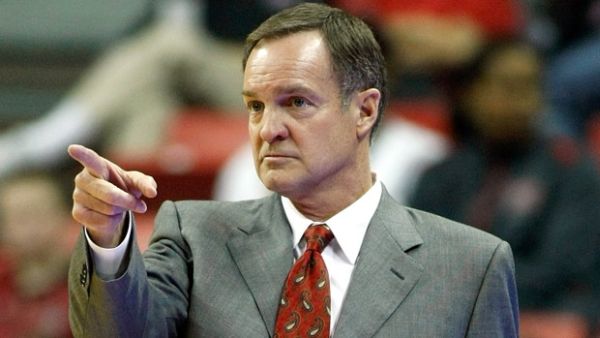Circled Wagons: A Peek at Oklahoma’s Red Hot Start
Posted by Shane McNichol on December 17th, 2015Early this season, we’ve seen a fair amount of national chatter about a lack of great teams in college basketball. The tent poles of recent dominance (e.g., Duke, Kentucky, Kansas) have all seemingly taken a half-step back this year and we’re left with an intriguing collection of very good teams. But as we sit halfway through December, there is one team that has won all seven of its games by an average margin of 24.8 PPG, with two victories over clubs in the KenPom top 40. That team is Oklahoma.
Lon Kruger’s club has admittedly played a less challenging schedule, ranked 223rd nationally to this point. Against that competition, though, they’ve impressed. Their wins include a true road game at Memphis, a neutral court drubbing of highly-ranked Villanova, and a waxing of Wisconsin in which the Badgers’ only lead was 3-0. Against their lesser opponents, the Sooners have notched four more wins, each coming by more than 23 points. Their 7-0 record represents one of only eight teams still unbeaten, and yet they aren’t drawing as much attention as you might expect. Oklahoma currently sits at #3 in the AP Poll, receiving zero first place votes and behind one-loss Kansas. So why aren’t more people buzzing about the Sooners as a potentially great team? And what has made them so outstanding this season? The answer to those questions might, somewhat shockingly, represent the same thing. Take a look at the table below featuring Oklahoma’s three-point shooting this season.
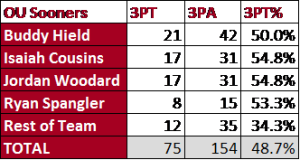
Oklahoma has pretty much scored at will this year, posting 87.9 points per contest. Four Sooners — Buddy Hield, Isaiah Cousins, Jordan Woodard and Ryan Spangler — stand out in particular, each averaging double figures and making more than 50 percent of their threes. In fact, Oklahoma is the team (at 48.7 percent) making the highest percentage of its three-point shots in the country. The spacing created by that kind of lights-out shooting is invaluable in the pick-and-roll game, on the dribble-drive, or on the block. That kind of shooting isn’t likely to continue all season, but a recent post over at KenPom.com examined the best way to project future three-point shooting success. Perhaps unsurprisingly, the best way to determine how well a team will shoot threes is how well a team has already shot threes. See the below graph.
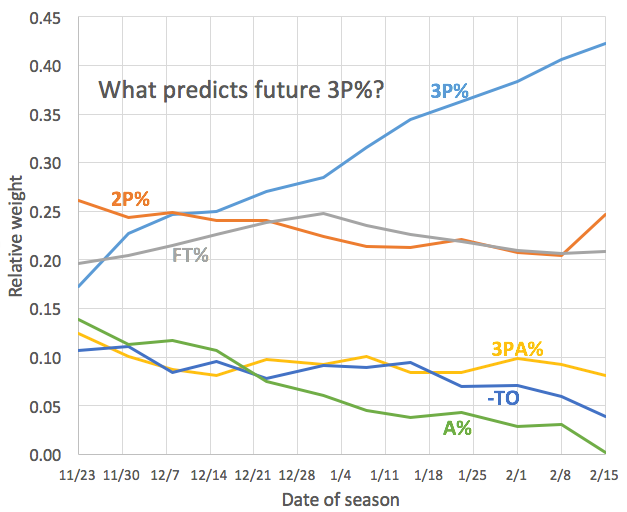
via KenPom.com
Note from the graph that a team’s two-point percentage is just as likely to predict future three-point success this early in the season. In the case of this Oklahoma group, that statistic could turn out to be troubling. See the below table.
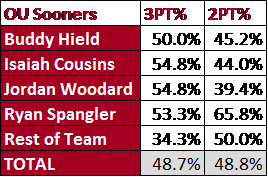
Through seven games, Oklahoma has shot nearly identical from both inside and outside the arc, spearheaded by its top three scorers all shooting better on three-pointers than two-pointers. The hope for Kruger is that the Sooners will be able to score more effectively inside the arc as their three-point well dries up a bit. Oklahoma’s current marks of 46.5 percent of its points coming from two-pointers and an even smaller 16.9 percent via the free throw line place the Sooners among the bottom 100 teams in Division I. The takeaway here is that teams that rely so much on three-point shooting are obviously prone to the volatility of cold shooting nights.
Luckily, even if the Sooners’ hot shooting goes ice cold, Kruger’s stingy defense should keep them competitive until shots start dropping. On that end of the floor, Oklahoma has done its best to mirror its offensive output. The Sooners are forcing opponents into shooting a measly 24 percent from behind the arc, the fourth lowest percentage nationally. Again, the same worries about sample size and regression to the mean are in play here, but KenPom also ran through the indicators of future three-point success allowed, with a surprisingly different result.
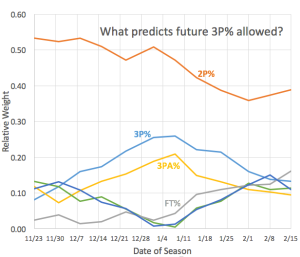
via KenPom.com
At any point during the season, the best predictor of allowing a high three-point percentage is the percentage allowed on two-point attempts. For Oklahoma, this is a crucial difference. Unlike on the offensive end where the Sooners’ success has been lopsided in favor of the deep ball, their defense has been just as effective inside the stripe. To date, they’ve allowed the 17th-lowest opponent’s two-point field goal percentage nationally. Kruger’s squad may not be the defensive equivalent of last year’s Kentucky team, but even the best offenses will struggle from time to time.
Oklahoma has used great shooting to jump out to a fast start this year. Conventional wisdom would believe it will crash back to Earth later this season, but the Sooners have enough defense to win some games regardless of whether their offense busts. In either case, wrestling the Big 12 title belt from its seemingly permanent home in Lawrence, Kansas, won’t be easy, but the Sooners’ ability to get scary hot from outside gives them a puncher’s chance as any league team of recent years. In this year of national parity, it also gives Oklahoma a chance to do a lot more than that.





























